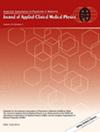A semi-supervised domain adaptation method with scale-aware and global-local fusion for abdominal multi-organ segmentation
Abstract
Background
Abdominal multi-organ segmentation remains a challenging task. Semi-supervised domain adaptation (SSDA) has emerged as an innovative solution. However, SSDA frameworks based on UNet struggle to capture multi-scale and global information.
Purpose
Our work aimed to propose a novel SSDA method to achieve more accurate abdominal multi-organ segmentation with limited labeled target domain data, which has a superior ability to capture the multi-scale features and integrate local and global information effectively.
Methods
The proposed network is based on UNet. In the encoder part, a scale-aware with domain-specific batch normalization (SAD) module is integrated to adaptively extract multi-scale features and to get better generalization across source and target domains. In the bottleneck part, a global-local fusion (GLF) module is utilized for capturing and integrating both local and global information. They are integrated into the framework of self-ensembling mean-teacher (SE-MT) to enhance the model's capability to learn common features across source and target domains.
Results
To validate the performance of the proposed model, we evaluated it on the public CHAOS and BTCV datasets. For CHAOS, the proposed method obtains an average DSC of 88.97% and ASD of 1.12 mm with only 20% labeled target data. For BTCV, it achieves an average DSC of 88.95% and ASD of 1.13 mm with 20% labeled target data. Compared with the state-of-the-art methods, DSC and ASD increased by at least 0.72% and 0.33 mm on CHAOS, 1.29% and 0.06 mm on BTCV, respectively. Ablation studies were also conducted to verify the contribution of each component of the model. The proposed method achieves a DSC improvement of 3.17% over the baseline with 20% labeled target data.
Conclusion
The proposed SSDA method for abdominal multi-organ segmentation has a powerful ability to extract multi-scale and more global features, significantly improving segmentation accuracy and robustness.


 求助内容:
求助内容: 应助结果提醒方式:
应助结果提醒方式:


